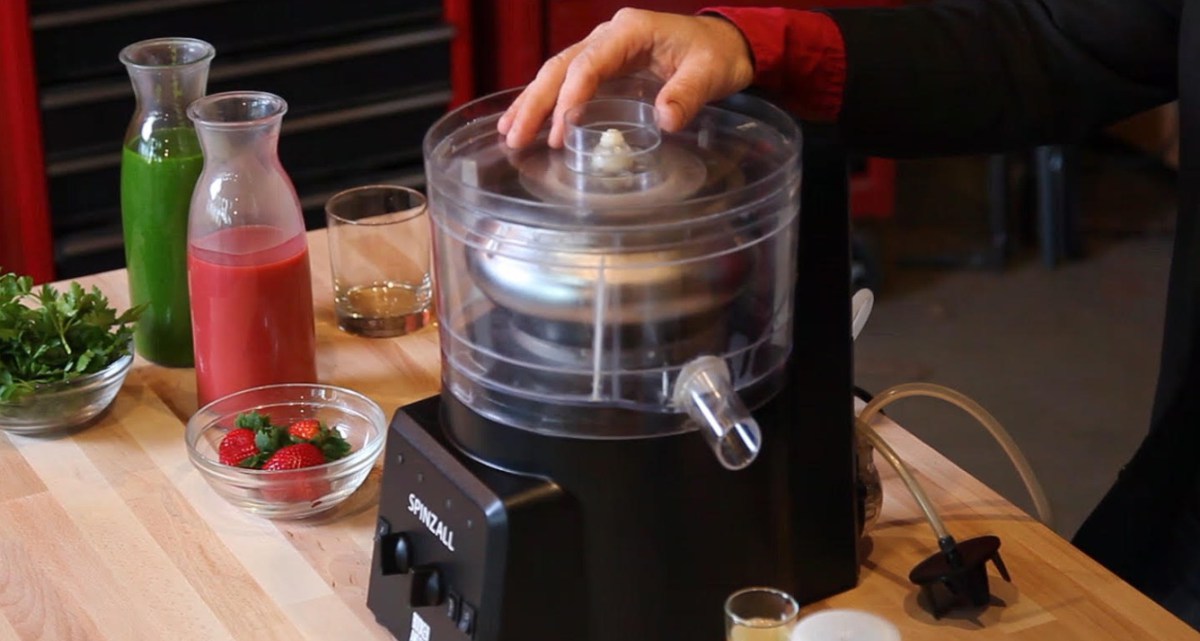Before astronauts go to space, they’re placed in a simulated cockpit that’s spun at the end of a long arm, subjecting them to several times the force of Earth’s normal gravity. While perhaps not pleasant, this training prepares them for the extremes they’ll encounter during space flight.
You can put food through this training too. All you need is a centrifuge.
Like astronauts, food and drinks are also highly susceptible to gravitational forces. Shake a bottle of cloudy apple juice, then leave it on the counter for a few hours. Under the force of gravity, the denser solid particles of fruit matter will slowly sink to the bottom.
The sedimentation that occurs naturally under normal Earth gravity happens much faster and more dramatically in a centrifuge, a machine designed for laboratories but now more and more popular in bars and restaurants. A tabletop centrifuge can spin at thousands of RPM and produce a force that’s thousands of times stronger than Earth’s gravity. As a juice or other mixture whirls in the ’fuge, it will separate into layers, with the denser components moving to the outside of the container.
Bars use centrifuges for exactly that purpose. The result? Clarified juices. (The main reason to clarify juice is that cloudy juice can’t be carbonated without frothing up, since the denser particles attract carbon dioxide bubbles. Clearing them out in a centrifuge means that any juice can be easily carbonated, making it easier to create new and interesting cocktails.)
Many other effects are possible by centrifuging food ingredients: concentrating syrups, turning normal yogurt into Greek-style thick yogurt, clarifying butter. Some of the earliest centrifuges were created to separate cream from milk (fat is less dense than water, so cream rises).
The Modernist Cuisine cookbook offers a number of recipes for centrifuge owners to try, including extracting hazelnut oil from roasted hazelnuts and separating out the natural fat that’s in green peas.
That was the first centrifuge recipe I tried at home, when the Modernist book came out in 2011. I had inherited a small centrifuge that fit on my counter, and so I immediately pureed peas, spooned them into six little test tubes, and fired the centrifuge up.
After several minutes of spinning, I stopped the machine and opened the test tubes. On top was a layer of clear green pea juice; on the bottom was starchy pale-green pea solids; and in a very thin layer between the two was pea fat. Success! The only hitch was that, from almost a half cup of peas, I was able to scrape out only about a half teaspoon of pea butter. The kind of centrifuge I could realistically fit into my apartment kitchen (like this one) was just too small to produce a useful amount. And the centrifuges bars use take up more space than my whole oven, cost thousands of dollars, and are very finicky to use.
That’s why I was excited to learn about the Spinzall last month, a new culinary centrifuge invented by my friend Dave Arnold and currently available for preorder. Although it’s no bigger than a food processor, it explicitly addresses that problem of small yield—instead of placing the ingredients in a spinning rack of test tubes, the Spinzall has just one big bucket, which can hold a half liter. There’s also a way to continuously pump food into and out of it, so you can get as much yield as you want.
I spoke to food writer and scientist Harold McGee about the possibilities that the Spinzall opens up for the home cook.
“The first thing that comes to my mind here in my own kitchen is being able to clarify stocks quickly rather than waiting for the separation of fat and liquid at 1G. I don’t currently do a lot with seed butters and oils or fruit juices, but that could change with a tool that looks so easy to work with. I’d love to make an oil from the amazing mango-flavored pistachios that I can occasionally get from Turkey, and pumpkin seed oil has always intrigued me, with its shifty chlorophyll-carotenoid color.”
We’re not quite at the point where centrifuges are common in home kitchens, but we may be on our way. Pea fat for all!
Do you use a centrifuge at home? Let us know in the comments or on our social media feeds.



